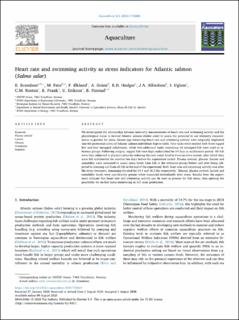| dc.contributor.author | Svendsen, Eirik | |
| dc.contributor.author | Føre, Martin | |
| dc.contributor.author | Økland, Finn | |
| dc.contributor.author | Gräns, Albin | |
| dc.contributor.author | Hedger, Richard David | |
| dc.contributor.author | Alfredsen, Jo Arve | |
| dc.contributor.author | Uglem, Ingebrigt | |
| dc.contributor.author | Rosten, Carolyn | |
| dc.contributor.author | Frank, Kevin | |
| dc.contributor.author | Erikson, Ulf Gøran | |
| dc.contributor.author | Finstad, Bengt | |
| dc.date.accessioned | 2020-08-28T11:28:49Z | |
| dc.date.available | 2020-08-28T11:28:49Z | |
| dc.date.created | 2020-08-26T11:54:27Z | |
| dc.date.issued | 2020 | |
| dc.identifier.issn | 0044-8486 | |
| dc.identifier.uri | https://hdl.handle.net/11250/2675534 | |
| dc.description.abstract | We investigated the relationship between telemetry measurements of heart rate and swimming activity and the physiological status in farmed Atlantic salmon (Salmo salar) to assess the potential to use telemetry measurements as proxies for stress. Sensor tags measuring heart rate and swimming activity were surgically implanted into the peritoneal cavity of Atlantic salmon individuals kept in tanks. Four tanks were stocked with three tagged fish and four untagged cohabitants, while two additional tanks containing 16 untagged fish were used as reference groups. Following surgery, tagged fish were kept undisturbed for 14 days as acclimation period. All fish were then subjected to physical stress by reducing the tank water level in 4 consecutive rounds, after which they were left undisturbed for another ten days before the experiment ended. Plasma cortisol, glucose, lactate and osmolality were measured to assess stress levels from fish in the reference groups before and after being subjected to stressing and from all fish at the end of the experiment. Both heart rate and swimming activity rose after the stress treatment, remaining elevated for 24.5 and 16.2 Hrs respectively. Glucose, plasma cortisol, lactate and osmolality levels were significantly greater when measured immediately after stress. Results from the experiment indicate that heart rate and swimming activity can be used as proxies for fish stress, thus opening the possibility for on-line stress monitoring in full scale production. | en_US |
| dc.language.iso | eng | en_US |
| dc.rights | Navngivelse 4.0 Internasjonal | * |
| dc.rights.uri | http://creativecommons.org/licenses/by/4.0/deed.no | * |
| dc.subject | plasma cortisol | en_US |
| dc.subject | lactate | en_US |
| dc.subject | glucose | en_US |
| dc.subject | osmolality | en_US |
| dc.subject | implants | en_US |
| dc.title | Heart rate and swimming activity as stress indicators for Atlantic salmon (Salmo salar) | en_US |
| dc.type | Peer reviewed | en_US |
| dc.type | Journal article | en_US |
| dc.description.version | publishedVersion | en_US |
| dc.rights.holder | © 2020 The Authors | en_US |
| dc.subject.nsi | VDP::Zoologiske og botaniske fag: 480 | en_US |
| dc.subject.nsi | VDP::Zoology and botany: 480 | en_US |
| dc.source.volume | 531 | en_US |
| dc.source.journal | Aquaculture | en_US |
| dc.identifier.doi | 10.1016/j.aquaculture.2020.735804 | |
| dc.identifier.cristin | 1825238 | |
| dc.relation.project | Norges forskningsråd: 280864 | en_US |
| cristin.ispublished | true | |
| cristin.fulltext | original | |
| cristin.qualitycode | 1 | |

